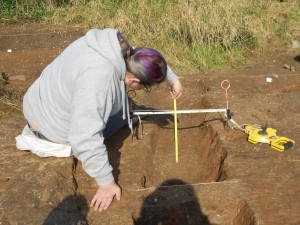Work has continued as expected at the Hatcliffe site with more feature excavations under way. From these features have emerged a steady flow of finds including sherds of pottery, fragments of bone and a cluster of oyster shells. The oysters were found in a tight group and are evidently discarded shells from a meal, on Roman sites we occasionally find clusters of oyster shells in features. This could be mean the oysters are consumed to mark particular calendar days (such as religious festivals or imperial celebrations) or celebrations relating to family events.
Several of the features have unearthed apparent corn dryers, these are similar in structure to kilns and were used to dry out the corn after it had been harvested. If this was barley, it may have been used for malting. This is supported by flecks of charcoal and burnt clay among the soil. Corn dryers were typically used in the later Roman era, which enables us to gain a better understanding of the site and it’s economy, and usage.
The undergraduates added to their skill set completing section and profile drawings of the features. A section drawing is when soil is still present in the feature, while a profile drawing is of an empty feature. The process of section and profile drawing begins with metal pegs known as arrows being inserted either side of the feature. A piece of string referred to as the datum line is tied at a right angle between the two arrow then a tape measure is attached with clips below the datum line. The distance from the base of the feature to the datum line is measured at 5cm intervals, the diagram in drawn onto graph paper and permatrace at a 1:10 scale to record the shape of the feature and any inclusions or variations in the soil.
Once the section and profile drawings were completed the team then moved onto levelling. This involves using a dumpy level on a tripod and a measuring staff to measure the height at the temporary bench mark (TBM), a known position, and the heights at the datum lines on the features. This was then recorded on the drawing board alongside the section and profile drawings. This process is useful for increasing the detail of the area we are working on and where the features are in relation to each other.
As our time at Hatcliffe draws nearer it is becoming ever more important to record the features, gathering as much information from them as possible, ensuring that no detail goes unnoticed.


